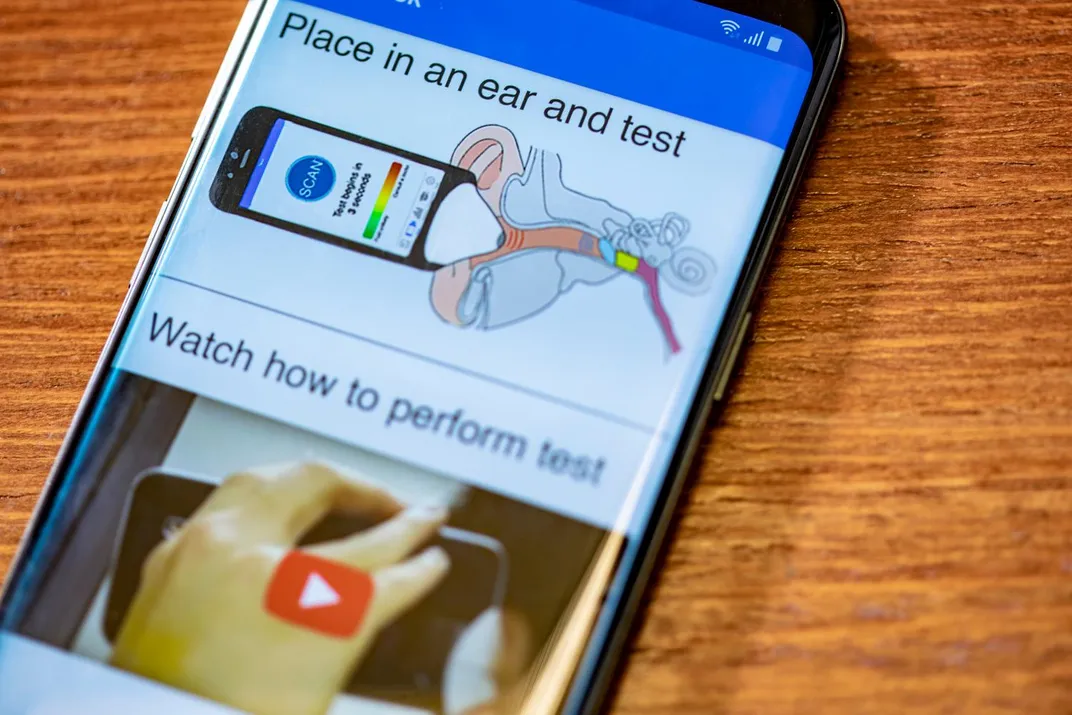Researchers Develop App That Plays Chirping Sounds to Check for Ear Infections
Although EarHealth isn’t currently available for purchase, the team hopes to receive F.D.A. approval by the end of 2019
/https://tf-cmsv2-smithsonianmag-media.s3.amazonaws.com/filer/d1/44/d1445237-295e-424a-8b90-a97be02a42d5/detecting_ear_fluid_web004.jpg)
By next year, parents may be able to gauge whether their child has an ear infection with nothing more than a smartphone and a rolled-up piece of paper.
As Ed Cara reports for Gizmodo, the key to this user-friendly, inexpensive test is a smartphone app called EarHealth. Created by scientists from the University of Washington and Seattle Children’s Hospital and Research Institute, EarHealth—newly described in the journal Science Translational Medicine—relies on chirping sounds to check for ear fluid indicative of infection.
Users must insert a makeshift funnel, easily crafted by folding a piece of paper, into the would-be patient’s outer ear and then play the chirps, sending sound waves bouncing from the middle ear back to the phone. Based on these reverberations, the app is able to determine if ear fluid is present and offer parents a reliable diagnosis without a doctor’s visit.
“It’s a little bit like tapping a wine glass,” co-lead author Justin Chan, a computer sciences engineer at University of Washington, tells Cara. “Depending on if the glass is empty or half-full, you’ll get a different sound. So it’s the same principle here.”
To train EarHealth’s algorithm, Chan and his colleagues conducted tests on 53 children aged 18 months to 17 years. Half of the subjects, all of whom were patients at Seattle Children’s, were in the hospital for scheduled ear tube implantation surgery, while the other half were set to undergo procedures unrelated to the ears. Overall, the team found that the app detected the presence of ear fluid with 85 percent accuracy and the absence of fluid with 80 percent accuracy.
Despite the fact that ear infections are the most common complaints behind pediatrician visits, diagnosis is notoriously difficult. The Associated Press’ Lauran Neergaard writes that primary care physicians typically look into a patient’s ear to check for inflammation, while specialists use high-cost tools such as a tympanogram to check for eardrum flexibility or stiffness. If the eardrum is pliable, it can likely vibrate enough to respond to sounds, but if it is stiff, built-up fluid pressure could be interfering with normal functions.

One of the main issues associated with diagnosing ear infections is the vague nature of symptoms associated with the condition. Tugging and pulling on the ears could signal infection, according to the National Institutes of Health, as could fussiness and crying, trouble sleeping, and fever. Then again, all of these symptoms could be manifestations of completely unrelated ailments, or even childhood crankiness.
Left unchecked, ear infections can cause serious health problems, including hearing loss and meningitis. Recurring infections pose an even greater threat and are often treated by implanting ventilating ear tubes.
Following initial trials, the Washington team conducted two additional rounds of testing. First, Gizmodo’s Cara notes, the researchers used the app on 15 children aged 9 to 18 months old. EarHealth correctly identified all five children with ear fluid and 9 of the 10 children without ear fluid. Finally, the team decided to see how parents fared while using the app. As Chan tells STAT’s Shraddha Chakradhar, the results were promising: 24 out of 25 parents who underwent several minutes of training arrived at the same results as physicians tasked with testing EarHealth, suggesting the app is simple enough for use by novices and experts alike.
Some experts have questioned just how useful EarHealth actually is, Richard Harris writes for NPR. Pamela Mudd, an ear, nose and throat specialist at Children's National Health System in Washington, D.C., says that not all fluid is linked to infection and emphasizes the importance of performing in-person examinations. She also raises concerns that parents, unable to interpret the app’s findings, will actually bring their children to the doctor unnecessarily, mistaking a temporary build-up of fluid for a serious infection.
Although EarHealth isn’t currently available via iPhone or android app stores, Chan and his colleagues hope to receive F.D.A. approval by the end of 2019 and launch the project shortly after. In addition to making the test available for home use, the team plans on working with physicians in developing countries to implement the technology in places that may not have access to specialist equipment.
/https://tf-cmsv2-smithsonianmag-media.s3.amazonaws.com/accounts/headshot/mellon.png)
/https://tf-cmsv2-smithsonianmag-media.s3.amazonaws.com/accounts/headshot/mellon.png)